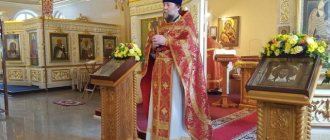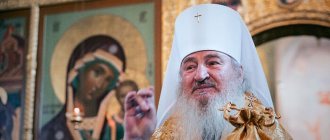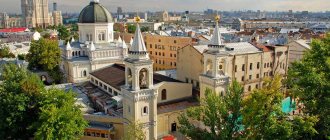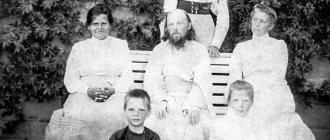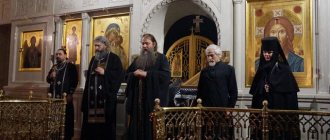Russian Orthodox Church
Autonomous non-profit organization "Central Clinical Hospital of St. Alexy, Metropolitan of Moscow, Moscow Patriarchate of the Russian Orthodox Church"
The history of the hospital dates back to the beginning of the 20th century: it was built in 1902 at the expense of the merchant-philanthropists Medvednikovs. The hospital complex included medical departments, an almshouse, a building for staff accommodation, outbuildings, a chapel and two churches. The opening of the hospital was attended by the Governor General of Moscow, Grand Duke Sergei Alexandrovich and Grand Duchess Elizaveta Feodorovna.
In 1918, the hospital was transformed into a tuberculosis hospital, and in 1922 it became a clinical hospital. Soon it was given the name that it retained for almost 30 years - the 5th Soviet Clinical Hospital. With the beginning of the Great Patriotic War, from the very first days, evacuation hospital No. 5018 was deployed on the territory of the hospital. After the war, the 5th Soviet hospital was renamed the 5th city hospital.
On May 26, 1992, the 5th City Clinical Hospital was transformed into the Central Clinical Hospital of St. Alexy, Metropolitan of Moscow, Moscow Patriarchate.
Today the Central Clinical Hospital of St. Alexia is a multidisciplinary medical institution of the Russian Orthodox Church with 250 beds. Every year, doctors see about 20 thousand patients, and more than 10 thousand people receive inpatient medical care.
St. Alexis Hospital is the educational and scientific base of the Russian National Research Medical University named after. N.I. Pirogov. Graduates of the St. Demetrius School of Sisters of Mercy also undergo internship here. The hospital employs 9 doctors and 19 candidates of medical sciences, 9 professors and 7 associate professors. 120 doctors and nurses have the highest and first qualification categories.
The hospital treats not only Muscovites, but also people from other regions of Russia, regardless of their religious affiliation. Many patients are admitted to the hospital by ambulance. For all patients, examination and treatment are provided free of charge.
The clinic includes a multidisciplinary surgical department, a consultation and diagnostic center, a department of functional and ultrasound diagnostics, an endoscopic department, an X-ray department with an MRI room, a physiotherapy department and a rehabilitation treatment department, and a patronage service. In the fall of 2016, a palliative care department began operating at the hospital.
On the territory of the Central Clinical Hospital of St. Alexy there are two hospital churches: St. Alexy, Metropolitan of Moscow, and the Tikhvin Icon of the Mother of God - the Patriarchal Metochion, as well as a chapel in honor of the Kozelshchansky Icon of the Mother of God.
Church of St. Alexia previously bore the name of the Kozelshchansky Icon of the Mother of God, in whose honor it was solemnly consecrated on June 20, 1904. The Kozelshchansky church was the only one in the Moscow province dedicated to this icon. Less than six months later, on November 10, 1904, Metropolitan Vladimir of Moscow and Kolomna consecrated the Church of the Tikhvin Icon of the Mother of God. In October 1918, both churches were separated from the hospital, later church property was confiscated, and in April 1923 the churches were sealed and soon they were destroyed. The revival of hospital churches and spiritual life in them began on March 6, 1992, when a prayer service for water was served in the Church of the Kozelshchanskaya Icon of the Mother of God for the first time in 70 years.
***
Director and chief physician of the hospital - A.Yu. Zarov.
Rector of the churches at the Central Clinical Hospital of St. Alexia - Archpriest Alexander Dokolin, honorary rector - Bishop Panteleimon of Vereya.
From the history of the creation of St. Alexius Hospital
Stanislav Velichko
Medvednikovs
On the longest street in Moscow, unfortunately also called Leninsky Prospekt, there is property No. 27. This most beautiful architectural ensemble of the capital, attracting the attention of everyone passing by, is more than 100 years old. The buildings, similar to a palace or a reputable bank, were once Medvednikovskaya and Rakhmanovskaya almshouses and a hospital. After the 1917 revolution, the entire complex became the Fifth City Hospital, and since 1992, a hospital named after St. Alexis, Metropolitan of Moscow and recently completely transferred to the Russian Orthodox Church. In the 19th century, the area where this hospital was built, south of the Garden Ring, near the Donskoy and St. Danilov monasteries, could be called an area of charitable institutions. From Kaluzhskaya Square to the Medvednikovsky and Rakhmanovsky almshouses there was a line of numerous establishments founded with funds from patrons. The Meshchansky almshouse and school were followed by the complexes of the 1st Gradskaya, Golitsynskaya and Shcherbatovskaya hospitals. Opposite them, after the Soldatenkovsky Textile School and the Rukavishnikovsky Primary School, is the Lyubimovskaya Hospital. The history of the creation of the Fifth City Hospital dates back to the first half of the 19th century and begins with the wealthy merchants Medvednikovs, who then lived in Irkutsk. Representatives of this famous Siberian merchant family conducted wholesale trade with China and Alaska. They imported tea and fabrics from the Celestial Empire, and in Alaska they exchanged various materials with the Aleut Indians for furs and gold. The Medvednikovs were famous philanthropists. In Irkutsk they set up an orphanage (orphanage) and a bank, the interest from which went to support this orphanage.
The Medvednikovs: Ivan Logginovich and Alexandra Ksenofontovna
By the 1850s, one of the representatives of the Medvednikov merchant family - the spouses Alexandra Ksenofontovna and Ivan Logginovich - moved to Moscow. Ivan Medvednikov enjoyed great authority both in Irkutsk, where he served as Mayor of the City, and in the capital city. Honesty, determination, resourcefulness - these are the qualities for which this merchant was valued. After his death, which followed in 1884, the widow Alexandra Ksenofontovna began to use all her funds for good deeds. An Exemplary Hospital was created in Irkutsk. In the Moscow region village of Porechye, near Zvenigorod, a shelter for elderly clergy and the Church of the Kazan Icon of the Mother of God were opened. The benefactor herself was buried in this church in 1899. According to her will, her entire fortune - more than 5 million rubles - was to be spent on charity in Moscow and Irkutsk. On the anniversary of the death of Alexandra Ksenofontovna, a funeral litany and memorial service were held in her parish church of John the Baptist in Starokonyushenny. How about. The Moscow Mayor, Prince, was also present. V.M. Golitsyn. It is worth noting that the state collected a tax of 152 thousand rubles from the five-million dollar will, but the cities of Moscow and Irkutsk started a legal battle against such robbery and won the case. The Minister of Finance S. Witte himself ordered the taken money to be returned. Approximately 2/3 of the capital (i.e., about 40%) was given to Moscow, the rest was sent to their homeland, to Irkutsk. The executor of the Medvednikovs, N.A. Tsvetkov, fulfilled the will of the testator. In Moscow, on Starokonyushenny Lane, in the possession of the Medvednikovs and with their bequeathed funds, one of the best gymnasiums in the city was built, which is still in operation today. 300 thousand was given to a shelter in Porechye. All churches in Moscow and Irkutsk were given a one-time payment of 100 rubles, and monasteries 10 thousand. Part of the funds was used to create parochial schools and distribute alms to the poor. According to the will of the Medvednikovs, about 1 million rubles were allocated for the creation of a hospital and almshouse in Moscow. For them, the city in 1900 bought land on B. Kaluzhskaya Street, demolished minor buildings and began construction of the buildings of the Medvednikovsky hospital and almshouse. The hospital and almshouse were intended for people “of the Christian faith, without distinction of rank, gender, or age.”
Hospital and almshouse named after. I. and A. Medvednikov Creation of a hospital and almshouse
The executors suggested that the talented architect, academician Sergei Ustinovich Solovyov, design the buildings. A graduate of the Imperial Academy of Arts, a member of the Moscow Archaeological Society, a teacher at the Stroganov School and the School of Painting, Sculpture and Architecture, he knew ancient Russian art very well, participated in the restoration of the Assumption Cathedral of the Kremlin, St. Basil's Cathedral. According to his drawings, a canopy was made over the relics of St. Basil the Blessed. Soloviev built many beautiful buildings in Moscow: the Church of the Sign in Kuntsevo and the Roman Sweet Singer in the Novospassky Monastery, the ensemble of the Serpukhov Monastery in honor of the icon “Otrada and Consolation”, the buildings of the Tretyakov Almshouse, the building of the Higher Courses for Women, now the Pedagogical University.
Drawings by Sergei Solovyov - a hospital, an almshouse and a chapel.
Solovyov designed the ensemble of Medvednikovsky buildings as an image of an ancient city. Three different-sized 2- and 3-story buildings with adjacent churches and a separate chapel looked very picturesque. The architect gave the facades the decor of Pskov churches and Pskov Pogankin Chambers. The fence was made in a very original way: round shields, above which rise the peaks of warriors, and helmet-shaped tops of invisible warriors invisibly “guard” the territory. Being an excellent watercolorist, Soloviev himself created sketches for the paintings of temples. Mosaics and facade ceramics were made according to his sketches. Above all the entrances there were mosaic images of St. St. George the Victorious - patron saint of Moscow. The mosaics were made by students of the Stroganov School. They also made carved metal parts - flag holders, brackets for gutters and cornices, crosses. Ceramic tiles and discs for wall decoration were made at the famous Abramtsevo factory of Savva Mamontov. The architect involved the “Heirs of P.P. Pashkov” workshop to paint the interiors of the temple. The decoration of the temples was unusual. There was no iconostasis in the usual sense; it was made directly on the wall of the temple. Only the first of its three tiers contained wooden icons. The ornaments and subjects were in many ways reminiscent of Russian frescoes of the 16th century. Construction and general improvement of the hospital and almshouse buildings lasted from 1901 to 1903. The completed institutions were named after the benefactor spouses. December 30, 1903 “With great celebration, the consecration of 2 buildings of the hospital for the terminally ill and the almshouse took place. I. and A. Medvednikov on Kaluzhskaya Street, opposite Neskuchny Garden. The consecration ceremony, which was performed by His Eminence Vladimir, Metropolitan of Moscow and Kolomna, was attended by... And. Highness V. Prince Sergei Alexandrovich and V. Prince. Elizaveta Feodorovna,” Fr. “Moscow Church Gazette” wrote that “in 1903, the consecration of institutions named after. I. and A. Medvednikovs - almshouses for 60 people of both sexes and sick people for 150 people, each of which, according to the will of A.K. Medvednikova, has its own church with small domes and belfries.” A few years later, funds were allocated from Medvednikovsky capital to support 8 more people. Each of the prisoners, who were kept for pay or without it, was fed three times a day, the nurses (nurses) monitored the health of the patients, took them for a walk in the garden or temple, if the patients could not move on their own, food was brought to the ward. Patients were entitled to a uniform, their own cutlery and hygiene utensils. Short services were held in churches twice a day.
Temples
In 1904, the built churches were consecrated: at the almshouse - in the name of the Tikhvin Icon, at the hospital - in the name of the Kozelshchansky Icon of the Mother of God. The executor of A. Medvednikova, hereditary honorary citizen of Moscow Nikolai Alekseevich Tsvetkov, became the temple publisher (the person who managed the capital given to charity) of both churches. The grandson of a priest, he was known in industrial Moscow as an excellent financier. Tsvetkov was deputy chairman of the Moscow Merchant Bank. He donated silver utensils and expensive vestments to the temples from his personal funds. The hospital church in the name of the Kozelshchansk Icon of the Mother of God was the first to be consecrated - June 20, 1904. The Kozelshchansky church was the only one in the Moscow province dedicated to this icon. The dedication was not chosen by chance. The Kaluga road led towards the south, Poltava region, where the icon was revealed in 1881.
The icon itself (ancient writing, 15th century) came to our country from Italy; one of the ladies-in-waiting of Empress Elizabeth Petrovna brought it with her. Her descendants, Counts Kapnista, carefully preserved the family shrine. One day, the daughter of Count V. Kapnist, Maria, fell ill with paralysis. No means helped, and the parents decided to take their daughter to Moscow to see a famous doctor. Before leaving, the mother asked her daughter to venerate the image and pray before the long journey. And a miracle happened. The room resounded with the girl's joyful cries. The mother was afraid that Masha had become mentally damaged, but when she saw her daughter walking around the room, she immediately spread the good news. People began to flock to the Kapnist house from all over the Poltava province. The icon was transferred to the Poltava Kozelshchansky Monastery. The day of the girl’s recovery, February 21, became the day of remembrance of the icon. A copy of the image was painted especially for the Moscow church in Poltava.
Currently, the temple is reconsecrated in honor of the patron saint of His Holiness Patriarch Alexy II, Saint Alexy of Moscow. On November 10 of the same 1904, Metropolitan Vladimir of Moscow and Kolomna consecrated the almshouse church in the name of the Tikhvin Icon of the Mother of God. This choice is also not accidental. The image was associated with the north of Russia, where another branch of the Kaluga road led. It is possible that the veneration of the icon in the Zvenigorod district, where the shelter was located in Porechye, influenced the choice. In October 1918, the hospital staff organized a parish community, since both churches were separated from the hospital. At the same time, valuable church property was confiscated. Despite all the efforts of the parishioners, in April 1923 the churches were sealed and soon destroyed.
Rakhmanovs
Ten years before the events described above, in 1908, the famous Moscow family of merchants, the Rakhmanovs, allocated funds for the construction of an almshouse. Brother and sister Ivan and Agniya Rakhmanov, in memory of their sisters Alexandra and Emilia and by their will, left Moscow a capital of 133 thousand rubles. It was decided to attach the almshouse to the already existing almshouse building of the Medvednikovs. The Rakhmanov merchants were known as major philanthropists who helped townspeople since the second half of the 18th century. Coming from the Guslitsky volost of the Moscow region, from an Old Believer family, they have long been engaged in the trade of bread, timber, and yarn. The Rakhmanovs' funds were used to build an Old Believer School, a House of Free Apartments, and an orphanage. They helped prisoners back in the days of Dr. F. Haas. It was decided to build an almshouse “for epileptics and idiots,” “no matter what religion they belong to.” The two-story building of the Almshouse named after. A. and E. Rakhmanov was also erected by S. Solovyov in 1908-1909 next to the Medvednikovskaya almshouse and had a separate entrance.
On January 4, 1910, “the consecration of the hospital, designed for 60 sick and crippled people, was consecrated. The hospital was built with funds bequeathed by E.K. Rakhmanova. Present at the consecration were: mayor N.I. Guchkov, sister of the late donor Agn.K. Rakhmanova, N.A. Tsvetkov, member of the Council N.F. Malinin, chief doctors of city hospitals and director of the Medvednikovsky almshouse S.Ya. Popov,” - reported the newspaper "Voice of Moscow". Moreover, the report incorrectly noted that the building was built with donations from Emilia alone.
Maintaining 60 patients cost 15 thousand rubles a year (i.e. 250 rubles per person). This amount far exceeded the contents in other Moscow almshouses. This made it possible not only to diversify the diet, but to replace caregivers with nurses, providing a level of care for the sick. For lunch and dinner, patients received lentil porridge, cabbage soup, borscht, roast, Varenets, cheese, and vegetables. In the morning they drank milk or jelly, ate oatmeal and semolina porridge.
Afterword
After the October Revolution, the almshouses were liquidated, and their premises were given over to the organized 5th city hospital. The chapel on the corner with M. Kaluzhskaya Street (no. 14) was built up to 3 floors and was disfigured. The Almshouse building housed the 1st surgical, 1st therapeutic departments and the electrocardiogram laboratory. Therapeutic departments were opened in the hospital building. The grave of I. Medvednikov in the Spas-Andronnikov Monastery was destroyed, the shelter and temple in Porechye with the grave of A. Medvednikova also disappeared from the face of the earth. In 1992, the Moscow government transferred the complex of the 5th City Hospital to the Moscow Patriarchate. Relatives of the merchants Medvednikovs come to the hospital church to serve funeral services for Alexandra and Ivan. Nowadays both churches - St. Alexei and the Tikhvin Icon - are operational. The paintings of the temples are being restored. The parishes have a pilgrimage service, a Sunday parish school, a city patronage service, and a library. The hospital itself may remain a monument where the destinies of Poltava and Tikhvin, Irkutsk and Pskov, Alaska and Italy came together.
Source: Mercy.ru
To patients of hospital No. 67 and their loved ones
Home For patients of hospital No. 67 and their loved ones
Not far from the Church of the Life-Giving Trinity in Khoroshevo there is city clinical hospital No. 67. The church community, led by the rector, Metropolitan Mark of Ryazan and Mikhailovsky, has long and fruitfully collaborated with the management and staff of this medical institution.
The priests of our temple visit hospital patients almost every day. In the hospital’s reception department (1st floor of building “G”) there is a prayer room where daily, except Sundays and twelve holidays (Christmas, Epiphany, etc.) prayers are held for the healing of the sick. The service begins at 15.00. Several icons for decorating the prayer room were given by His Holiness Patriarch Kirill of Moscow and All Rus'.
Sisters of mercy from the Sisterhood in honor of the holy great martyr and healer Panteleimon are on duty in the prayer room from Monday to Saturday Here they will gladly answer your questions about faith and the Church, about worship and church practice, pray with you, and help organize a visit to the sick priest for confession and Communion of the Holy Mysteries of Christ. Here you can light candles, leave notes with names for prayerful remembrance, draw holy water, take spiritual books, and a pectoral cross.
Prayer room phone number: +79295406585 (Elena). Please don't hesitate to call back if you don't get an answer right away.
About the performance of church sacraments in hospital No. 67.
- Confession and communion for patients who cannot come to church are performed daily, except on Sundays and holidays, when our priests are busy in the church. It is necessary to understand that communion outside the church is an extreme measure, and the opportunity to approach the shrine of the Body and Blood of Christ outside the church service can never serve as an excuse for negligence about church life outside the walls of the hospital. It is also necessary to understand that the decision about whom, when and where to give communion and whether to give communion at all is made by the priest. For example, it is impossible to confess and give communion to a person who is not conscious. Those wishing to confess and receive communion must inform the sister on duty in the prayer room about their intention. If the prayer room is already closed, and the patient is in extremely serious condition and there is a danger of imminent death, the priest can be invited directly to the temple (Karamyshevskaya embankment, 15, about 10 minutes walk from the hospital) or by contacting the duty officer at the temple by phone +74991973029 .
- Baptism of adults in the event of danger of imminent death is carried out as quickly as possible. In such cases, you must immediately contact the duty sister in the prayer room ( +79295406585 ).
- Baptism of infants in the Children's Department or in the Maternity Department (the building is currently closed for reconstruction) is carried out in agreement with the attending physician, usually after 16.00. In urgent cases (if there is a threat of imminent death or on the eve of a complex operation on vital organs, etc.), baptism can be performed at another time, which also must be agreed with the doctor. Baptism should be arranged with the priest in the prayer room, or in the church in person or by phone +74991973029 .
- The Sacrament of Anointing (unction) is performed, according to tradition, “once in sickness,” that is, once per illness. The performance of this sacrament requires prior agreement with the priest. To do this, you need to call the temple phone number +74991973029 .
Patient care courses have been completed at the Training Center of St. Alexius Hospital in Moscow
Moscow, June 1, 2021
On-site practical master classes in Nizhny Novgorod
The Training Center of the St. Alexis Hospital has completed training courses for junior nurses in caring for the sick, Diakonia.ru reports. The training was carried out by nurses of the Nizhny Novgorod, Belgorod and Pereslavl dioceses. The courses were organized by the Training Center of St. Alexius Hospital together with the Synodal Department for Charity and the Association of Sisterhoods of Charity of the Russian Orthodox Church. The training included theoretical classes via distance learning and on-site practical master classes. In Nizhny Novgorod and Belgorod, course graduates plan to continue caring for patients in hospitals and at home.
“The mission of our Training Center is to train personnel to care for seriously ill people. There are many people who want to study not only in Moscow, but also in other regions of the Russian Federation. That is why the Training Center provides training in other regions. We congratulate our graduates on completing their studies and wish them success on their difficult but vital path,” said Olga Bazhenova, head of the Training Center at St. Alexis Hospital.
Training began in March 2021. The theoretical part was held remotely. Listeners participated in webinars and were also provided with additional materials for independent study. In May 2021, teachers of the Training Center conducted on-site master classes where they developed practical skills in caring for seriously ill people. The course ended with exams, based on the results of which students will be issued state certificates.
On-site practical master classes in Nizhny Novgorod
“In recent years, many new sisters and volunteers have come to our sisterhood who have a great desire to do good deeds, but lack the skill. People often turn to us for advice and help in caring for seriously ill relatives. You have to provide care after a stroke, after surgery, in a hospital or at home. Nursing skills and knowledge are very important for this. After all, learning foster care makes life easier not only for the patient, but also for the whole family,” said Elena Khimchenko, senior sister of the Marfo-Mariinsky Sisterhood of Charity in Belgorod.
The Sisters of Charity of the Cathedral in honor of the Holy Blessed Prince Alexander Nevsky of Nizhny Novgorod cooperate with five medical institutions in the city. According to the cathedral's sister of mercy, Maria Dugina, the decision on the need for training was due to a shortage of medical personnel. “The patient needs to be fed, washed, and communicated. When a patient has severe bedsores, they need to be turned every two hours. Then we realized that we need to develop in the direction of caring for the sick,” shared Maria Dugina.
The Sisterhood of Mercy in Pereslavl-Zalessky is still in its infancy. The St. Luke Center is being created in the city; in 2021, they plan to open a branch of the St. Alexius Hospital.
“On this territory there are buildings of the former zemstvo hospital, where from 1910 to 1917 the chief physician and surgeon Valentin Feliksovich Voino-Yasenetsky, the future Saint Luke, worked. It is very important for us to continue his works of mercy,” commented Yulia Tovstaya, project coordinator at the St. Luke’s Center.
It is worth noting that in 2021, sisters of mercy from 14 regions are undergoing training at the Training Center of St. Alexius Hospital.
The Central Clinical Hospital of St. Alexy Metropolitan of Moscow is a multidisciplinary medical institution with 280 beds. This is the largest medical institution of the Russian Orthodox Church. The hospital treats people from all regions of Russia, regardless of their religious affiliation. For all patients, examination and treatment are provided free of charge. Since 2021, the hospital has been operating a licensed Training Center. It trains junior nurses to care for the sick and organizes advanced training courses for nurses. The center issues state certificates.
The training center is supported by the Presidential Grants Fund and the Elena and Gennady Timchenko Charitable Foundation.
The Association of Sisterhoods of Mercy organizes traveling seminars and master classes for sisters of mercy throughout the country. Master classes are conducted by nurses of the Sisterhood in the name of the blessed Tsarevich Dimitri, who have 30 years of experience in organizing care in institutions and at home.
